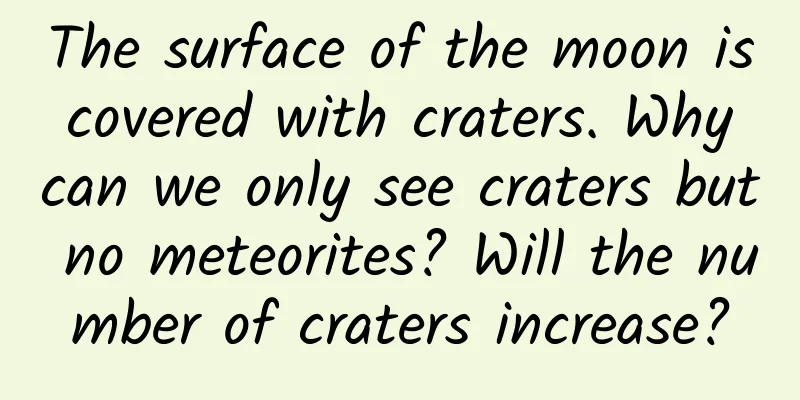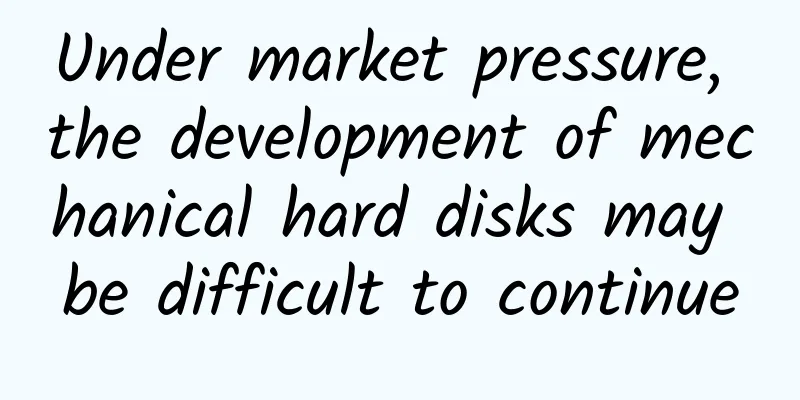The surface of the moon is covered with craters. Why can we only see craters but no meteorites? Will the number of craters increase?

|
The moon is the closest celestial body to the earth in the universe. As the earth's little follower, the average distance between the moon and the earth is only about 380,000 kilometers. If calculated based on the speed of Sun Wukong, who can travel 108,000 miles with one somersault, it only takes a dozen seconds to go to the moon. Although the distance between the moon and the earth is very close, the difference between the two is extremely obvious. Not to mention the internal differences, the appearance alone is very different. When it comes to the appearance of the moon, the most typical feature is the dense craters. This itself is nothing special. After all, there are a large number of small celestial bodies floating in the universe, and it is common for these small celestial bodies to collide with other celestial bodies under the action of gravity. What is puzzling is that the distance between the moon and the earth is so close, why are there so many craters on the moon, but they are extremely rare on the earth? There are roughly three reasons for the difference in appearance between the earth and the moon. The first is the protective effect of the moon on the earth. There are a large number of free small celestial bodies in the universe. Sometimes they are affected by the earth's gravity and move towards the earth. When they come around the earth, they are blocked by the moon, so they collide with the moon and form craters. Of course, the moon cannot block all attacks for the earth. Some small celestial bodies will still fall to the earth. However, these celestial bodies are very small and are eroded by friction in the process of entering the earth's atmosphere. They are often completely eroded before they fall to the ground. Occasionally, some larger small celestial bodies fall to the earth. Because of their large size, they are not completely eroded in the friction with the atmosphere. They come into contact with the surface and form small-scale craters. However, the natural environment of the earth is changeable and complex. With the wind and rain over the years, the craters gradually disappear. Based on the above three reasons, it is difficult for us to find decent craters on the earth. The moon is different. It is located outside the earth and orbits the earth. It naturally becomes a shield for the earth, so it will be hit by more meteorites than the earth. Since the moon has no atmosphere, meteorites will directly hit the moon at high speed under the influence of the moon's gravity, and will create a huge crater after coming into contact with the lunar surface. Of course, this is also related to the texture of the lunar soil itself. Compared with the earth's soil, the lunar soil is relatively thin and soft. Once formed on the moon, craters are difficult to disappear because the moon does not have a complex and changeable natural environment like the earth. Because of this, as time goes by, craters continue to accumulate on the surface of the moon, and the piles are getting bigger and bigger. Smaller craters are superimposed on the larger craters. After more than four billion years, the moon has finally become a pockmarked face. So how many craters are there on the moon? The moon is not a very large celestial body. Its diameter is only 3476.28 kilometers. However, even such a small celestial body has countless meteorite craters. If you add up all the craters on the moon, there are simply too many to count, so we only count the larger ones. Are craters with a diameter of more than ten kilometers large enough? There are tens of thousands of such huge craters on the moon, and the exact number has not yet been counted. Are there bigger craters on the moon? Of course there are. Many large craters on the moon are even more than 100 kilometers in diameter, and this is not the largest one. It is hard to imagine how spectacular the impact was when there was a crater with a diameter of 1,000 kilometers on a planet with a diameter of only more than 3,000 kilometers. So is the number of craters on the moon still increasing? Of course, the number of impacts on the moon can still reach thousands every year, but the scale of these thousands of impacts is usually small, and the diameter of these meteorites that collide with the moon is usually no more than ten meters. There are a large number of craters on the moon, and the number is increasing by thousands every year. But why are there only craters on the moon, but no meteorites? In fact, there are meteorites, but we just can't see them. When a meteorite hits the lunar surface, the soil on the lunar surface will splash around, forming a large pit. What splashes out is not only the lunar soil, but also part of the meteorite. Because the strong impact force will damage the meteorite, the damaged part will turn into fragments and splash out, and part will directly melt and disappear in the high temperature generated by the impact. Of course, the part that is smashed and melted is limited, so where does the main body of the meteorite go? Do you remember the difference between lunar soil and earth soil? The lunar soil is thin and soft. Under a strong impact, meteorites will directly drill into the soil. In other words, meteorites actually exist, but they are all under the surface of the moon and we can't see them. For more information, please follow the official account: Supreme Scientific Faith |
<<: Wearing a mask = sun protection? Don’t be naive! Dermatologists give 6 suggestions!
>>: When talking about Su Shi, you can't just know Dongpo pork
Recommend
What is the difference between Baidu search promotion and online alliance promotion?
What is the difference between Baidu search promo...
Make money in SEO business with nothing! Earning a thousand dollars a day is not a dream!
Baidu seems to be getting less and less popular. ...
Put everything in the refrigerator? Be careful, it will go bad faster!
Lock the refrigerator to keep it fresh | Tuchong ...
What is the difference between "sand" and "grit"? You should know some scientific knowledge!
1. What is the difference between "sand"...
[Smart Farmers] It’s time to change the idea that “eating sugar causes tooth decay”! There are more than one “culprit” for tooth decay
Why are we taught from a young age that "chi...
Lao Duan said: Four key changes in Internet TV
In 2013, the Internetization of television became...
Read the full text of The Widowed Sister-in-law novel for free, and read the full text of The Rural Widowed Sister-in-law for free without pop-ups!
Introduction to the novel of the widowed sister-i...
Yiche Statistics: In the 49th week of 2023, the weekly sales of Wenjie M7 has reached 4,700 units, ranking first among the TOP10 weekly sales of medium and large SUVs in the Chinese passenger car market.
The world of questions has completely come alive....
I made one million a year selling health products. Can I make money selling health products for the elderly?
I once attended a training course at a certain in...
Decipher Momo optimization techniques and master information flow advertising!
Momo is a pan-entertainment social platform that ...
Collect them now! These flower-viewing tips will definitely come in handy for your spring outing!
From the last glimmer of snow to the last drop of...
Are nitrogen and carbon related in the forest? Uncovering the love-hate relationship between nitrogen and carbon
The increase in atmospheric carbon dioxide concen...
China Automobile Dealers Association: Regional market analysis of new energy passenger vehicles in March 2022
According to the China Passenger Car Association&...
my country's first Mars exploration mission achieves rich scientific results
According to the National Space Administration on...
How to apply for a 400 telephone number?
Nowadays, there are many 400 telephone service pl...









